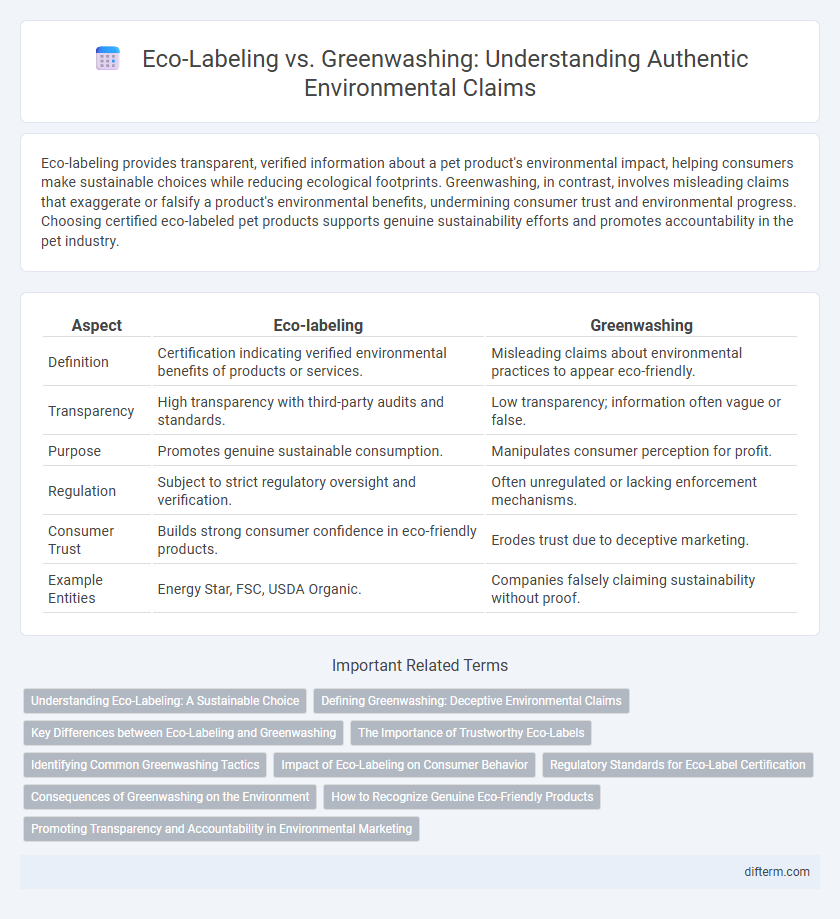Eco-labeling provides transparent, verified information about a pet product's environmental impact, helping consumers make sustainable choices while reducing ecological footprints. Greenwashing, in contrast, involves misleading claims that exaggerate or falsify a product's environmental benefits, undermining consumer trust and environmental progress. Choosing certified eco-labeled pet products supports genuine sustainability efforts and promotes accountability in the pet industry.
Table of Comparison
| Aspect | Eco-labeling | Greenwashing |
|---|---|---|
| Definition | Certification indicating verified environmental benefits of products or services. | Misleading claims about environmental practices to appear eco-friendly. |
| Transparency | High transparency with third-party audits and standards. | Low transparency; information often vague or false. |
| Purpose | Promotes genuine sustainable consumption. | Manipulates consumer perception for profit. |
| Regulation | Subject to strict regulatory oversight and verification. | Often unregulated or lacking enforcement mechanisms. |
| Consumer Trust | Builds strong consumer confidence in eco-friendly products. | Erodes trust due to deceptive marketing. |
| Example Entities | Energy Star, FSC, USDA Organic. | Companies falsely claiming sustainability without proof. |
Understanding Eco-Labeling: A Sustainable Choice
Eco-labeling certifies products that meet strict environmental standards, ensuring consumers make sustainable choices by identifying items with reduced ecological impact. This transparent system promotes responsible production and consumption, fostering trust through verified claims rather than misleading marketing. Clear eco-labels help differentiate genuinely green products from deceptive greenwashing, protecting both the environment and informed buyers.
Defining Greenwashing: Deceptive Environmental Claims
Greenwashing involves making deceptive environmental claims that mislead consumers about the true sustainability of a product or company. Unlike authentic eco-labeling, which relies on verified standards and transparent criteria, greenwashing often exaggerates or fabricates the environmental benefits to improve public perception. This practice undermines genuine sustainability efforts and contributes to consumer mistrust in environmental certifications.
Key Differences between Eco-Labeling and Greenwashing
Eco-labeling provides verified information on a product's environmental impact through third-party certifications, ensuring transparency and consumer trust. Greenwashing involves misleading claims that exaggerate or fabricate a product's eco-friendly attributes, aimed at enhancing brand image without real environmental benefits. The key difference lies in the authenticity and accountability of eco-labeling compared to the deceptive marketing tactics of greenwashing.
The Importance of Trustworthy Eco-Labels
Trustworthy eco-labels provide credible information about a product's environmental impact, enabling consumers to make informed and sustainable choices. Unlike greenwashing, which misleads through false or exaggerated claims, authentic eco-labels undergo rigorous third-party verification and adhere to established environmental standards. Strengthening the integrity of eco-labeling supports transparency, promotes genuine sustainability practices, and fosters consumer confidence in environmentally responsible products.
Identifying Common Greenwashing Tactics
Common greenwashing tactics include vague or misleading claims such as "eco-friendly" without certification, use of irrelevant labels that do not guarantee sustainability, and hidden trade-offs where a product is marketed for one green attribute while ignoring other significant environmental impacts. Companies often employ imagery of nature or use earth-tone colors to create a false impression of environmental responsibility, even when their practices are harmful. Consumers should look for verified eco-labels like ENERGY STAR, Fair Trade, or USDA Organic to reliably identify genuinely sustainable products.
Impact of Eco-Labeling on Consumer Behavior
Eco-labeling significantly influences consumer behavior by providing credible information about a product's environmental impact, encouraging more sustainable purchasing decisions. Studies indicate that consumers are more likely to choose products with recognized eco-labels, perceiving them as trustworthy and environmentally responsible. The presence of transparent and verified eco-labels reduces confusion and counters the deceptive effects of greenwashing, fostering increased market demand for genuinely sustainable goods.
Regulatory Standards for Eco-Label Certification
Regulatory standards for eco-label certification establish rigorous criteria to verify genuine environmental benefits, ensuring transparency and accountability in product claims. These standards typically involve third-party audits, lifecycle assessments, and adherence to national or international environmental guidelines. Strict enforcement of such regulations helps consumers distinguish authentic eco-friendly products from deceptive greenwashing practices.
Consequences of Greenwashing on the Environment
Greenwashing misleads consumers by falsely portraying products as environmentally friendly, which undermines genuine sustainability efforts and delays critical environmental progress. This deceptive practice results in continued pollution, resource depletion, and increased carbon emissions as companies avoid implementing real eco-friendly measures. The environmental consequences include accelerated habitat destruction, biodiversity loss, and failure to meet climate targets due to misplaced consumer trust and ineffective regulations.
How to Recognize Genuine Eco-Friendly Products
Genuine eco-friendly products display certified eco-labels from reputable organizations such as USDA Organic, Energy Star, or Forest Stewardship Council (FSC), which verify sustainable practices and environmental impact. Consumers can recognize authenticity by cross-referencing these labels with official databases and assessing product transparency regarding sourcing, manufacturing processes, and carbon footprint. Avoiding vague claims like "green" or "eco-friendly" without specific certifications helps prevent falling for greenwashing tactics designed to mislead buyers.
Promoting Transparency and Accountability in Environmental Marketing
Eco-labeling provides verifiable certifications that help consumers identify genuinely sustainable products, enhancing transparency in environmental marketing. In contrast, greenwashing employs misleading claims to falsely portray products as eco-friendly, undermining consumer trust and accountability. Promoting clear standards and independent audits strengthens the credibility of environmental claims and supports responsible consumer choices.
eco-labeling vs greenwashing Infographic

 difterm.com
difterm.com